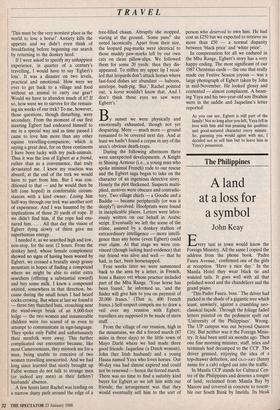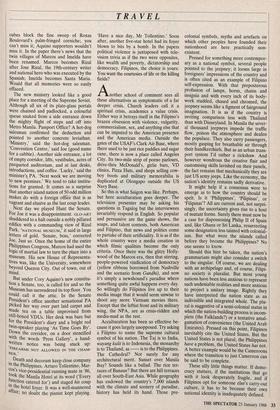The Philippines
A land at a loss for a symbol
John Keay
Every taxi in town would know the Foreign Ministry. All the same I copied the address from the phone book. 'Padre Faura Avenue,' confirmed one of the girls at reception. 'Have a nice day.' In the Manila Hotel they wear black tie and waisted tails. It goes well with all that polished wood and the chandeliers and the grand piano.
`This Padre Faura, boss.' The driver had parked in the shade of a gigantic tree which leant, unwisely, against a crumbling neo- classical façade. Through the foliage faded letters painted on the pediment spelt out `University of the Philippines'. Wrong. The UP campus was out beyond Quezon City. But neither was it the Foreign Minis- try. It had been until six months ago. Then one fine morning minister, staff, telex and terminals had decamped to the CCP. The driver grinned, enjoying the idea of a top-drawer defection, and GLO-ART (funny name for a cab) edged out into the traffic.
In Manila CCP stands for Cultural Cen- tre of the Philippines and denotes a tongue of land, reclaimed from Manila Bay by Marcos and covered in concrete to resem- ble our South Bank by Imelda. Its bleak
TRAVEL
cubes block the fine sweep of Roxas Boulevard's palm-fringed corniche; you can't miss it; Aquino supporters wouldn't miss it. In the paper there's news that the twin villages of Marcos and Imelda have been renamed. Marcos becomes Rizal after Jose Rizal, the 19th-century writer and national hero who was executed by the Spanish; Imelda becomes Santa Maria. Would that all memories were so easily effaced.
The new ministry looked like a good place for a meeting of the Supreme Soviet. Although all six of its plate-glass portals were chained and padlocked, a colourful queue snaked from a side entrance down the mighty flight of steps and off into Metro Manila. Passport Office? A hot-dog salesman confirmed the deduction and pointed to another concrete leviathan. `Ministry,' said the hot-dog salesman. `Convention Centre,' said Joe (good name for a cabbie). Another side entrance, a lot of empty corridor, lifts, vestibules, acres of parqueted auditorium, and at last desks, introductions, and coffee. 'Lucky,' said the minister's PA. 'Next week we are moving to new premises.' We tend to take institu- tions for granted. It comes as a surprise that another island nation of 50 odd million makes do with a foreign office that is as vagrant and elusive as the last coup leader.
Next day we played Hunt the Senate. For Joe it was a disappointment. GLO-ART shuddered to a halt outside a nobly pillared edifice with a commanding view of Rizal Park. 'NATIONAL MUSEUM,' it said in large letters of gold. 'Senate, boss,' corrected Joe. Just so. Once the home of the entire Philippines Congress, Marcos had used the logic of martial law to turn the place into a museum. His new House of Representa- tives was, like the University, somewhere beyond Quezon City. Out of town, out of mind.
But under Cory Aquino's new constitu- tion a Senate, too, is called for and so the Museum has surrendered its top floor. You could call it the attic. In the Senate President's office another sensational PA picked her way over part laid carpet and made tea on a table improvised from still-boxed VDUs. Her desk was bare but for the President's diary and a bright red twin-speaker playing 'As Time Goes By'. Down the corridor, on a door stencilled with the words 'Press Gallery', a hand- written notice was being stuck up: 'FIREARMS NOT ALLOWED IN THE CHAM- BER.'
Death and decorum keep close company in the Philippines. Arturo Tollentino, Mar- cos's vice-presidential running mate in '86, took the Manila Hotel at its word (Every function catered for') and staged his coup in the hotel foyer. It was a well-mannered affair; no doubt the pianist kept playing. `Have a nice day, Mr Tollentino.' Soon after, another five-star hotel had its foyer blown to bits by a bomb. In the papers political violence is juxtaposed with tele- vision trivia as if the two were opposites, like wealth and poverty, dictatorship and democracy. Filipinos, the choice is yours: You want the courtesies of life or the killing fields?
Another school of comment sees all these alternatives as symptomatic of a far deeper crisis. Church leaders call it a spiritual crisis, academics a value crisis. Either way it betrays itself in the Filipino's brazen obsession with violence, vulgarity, commercialism, sex, and anything else that can be imputed to the American presence and the American media. Outside the gates of the USAF's Clark Air Base, where there used to be just rice paddies and sugar cane, there is now a place called Angeles City. Its two-mile strip of porno parlours, drive-thru McDonald's, girlie bars, VD clinics, Pizza Huts, and shops selling cow- boy boots and military memorabilia is duplicated at Olongapo outside the US Navy Base.
So this is what Saigon was like. Perhaps, but here acculturation goes deeper. The television presenter may be asking his questions in Tagalog but the interviewees invariably respond in English. So popular and persuasive are the game shows, the soaps, and talent contests, both American and Filipino, that news and politics come to partake of their artificiality. It is as if the whole country were a media creation in which filmic qualities become the only criteria. Once there was the glitzy Holly- wood of the Marcos era, then that stirring, people-powered vindication of democracy (yellow ribbons borrowed from Nashville and the scenario from Gandhi), and now it's simply a newshound's paradise where something quite awful happens every day. So willingly do Filipinos live up to their media image that it would seem unwise to shoot any more Vietnam movies there. Except that the leftist front and its military wing, the NPA, are as crisis-ridden and media-mad as the rest.
Acculturation has been so effective be- cause it goes largely unopposed. Try asking a Filipino to name the supreme cultural symbol of his nation. The Taj is to India, wayang kulit is to Indonesia, the monarchy is to Thailand, as — is to the Philippines.
The Cathedral? Not surely for any architectural merit. Sunset over Manila Bay? Sounds like a ballad. The rice ter- races of Banaue? But there are hill terraces all over South-East Asia. While geography has endowed the country's 7,000 islands with the climate and scenery of paradise, history has held its hand. Those pre- colonial symbols, myths and artefacts on which other peoples have founded their nationhood are here practically non- existent.
Pressed for something more contempor- ary as a national symbol, several people pointed to the jeepney; it looms large in foreigners' impressions of the country and is often cited as an example of Filipino self-expression. With that preposterous profusion of lamps, horns, chains and insignia and with every inch of its body- work studded, chased and chromed, the jeepney seems like a figment of fairground imagination. It is as if the country is inviting comparison less with Thailand than with Disneyland. In Manila the sever- al thousand jeepneys impede the traffic flow, poison the atmosphere and deafen the populace. They also carry passengers, mostly gasping for breathable air through their handkerchiefs. But as an urban trans- port system I'd rather a rickshaw. And however wondrous the creative flair and customising skills lavished on their panels, the fact remains that mechanically they are just US army jeeps. Like the economy, the nation's identity remains sadly derivative.
It might help if a consensus were to emerge as to how the country should be spelt. Is it 'Philippines', `Pilipinas', or `Filipinas'? All are current and, not surpri- singly, the uncertainty gives rise to a host of mutant forms. Surely there must now be a case for dispossessing Philip II of Spain and, like Ghana or Sri Lanka, resurrecting some designation less tainted with colonial- ism. But what were the islands called before they became the Philippines? No one seems to know.
Should this hint be taken, the nation's grammarians might also consider a switch to the singular. Of course, we are dealing with an archipelago and, of course, Filipi- no society is pluralist. But most young nations have been less anxious to represent such undeniable realities and more anxious to project a unitary image. Rightly they have interpreted the nation state as an indivisible and integrated whole. The plu- ral is suggestive of a semi-colonial status in which the nation-building process is incom- plete (the Falklands?) or a tentative amal- gamation of convenience (the United Arab Emirates). Pressed on this point, Filipinos inevitably cite the United States. But the United States is not plural; the Philippines have a problem, the United States has not. A better example would be the Cameroons where the transition to just Cameroon can be said to be complete.
These silly little things matter. If demo- cracy stutters, if the institutions that go with it look desperately fragile, and if Filipinos opt for someone else's carry-out culture, it has to be because their own national identity is inadequately defined.



























































 Previous page
Previous page